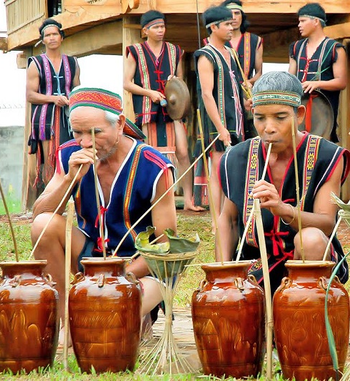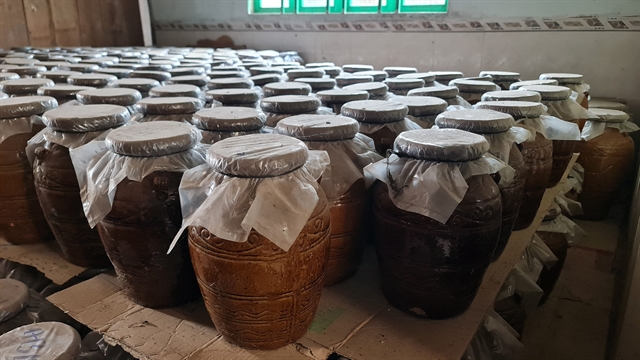 Features
Features

The rice-wine making of the S’Tiêng ethnic minority in the southern province of Bình Phước has been recognised as a national intangible cultural heritage in folk knowledge and traditional craft.
The rice-wine making of the S’Tiêng ethnic minority in the southern province of Bình Phước has been recognised as a national intangible cultural heritage in folk knowledge and traditional craft.
The provincial Department of Culture, Sports and Tourism has held a ceremony to announce the Ministry of Culture, Sports and Tourism’s recognition of the wine, called "đ’rắp s’lung" or "rơ nơm đ’rắp" in the S'Tiêng language.
But it is commonly called "rượu cần" in Vietnamese because it is usually drunk collectively through bamboo stems from a big jar. It is also called "stem wine" or "jar wine" by foreigners.
"Stem wine" is indigenous to several ethnic groups in Việt Nam, particularly in the Central Highlands and the mountainous regions in the North.
It is made from sticky rice mixed with various kinds of herbs and yeast, including leaves, barks and roots gathered from the local forests.
This mixture is then put into a big terracotta jar, covered and left to ferment for one or two months. The type and amount of rice and yeast added differ according to each ethnic group and region.
The craft relies on the accurate identification and use of natural materials, as well as a unique blend of yeast and rice to create a wine with distinct flavours. The wine contributes to the richness and diversity of the culinary culture of Bình Phước, and Việt Nam as a whole.
Unique drink

|
| The ethnic S'Tiêng rice wine is fermented in a big jar and drunk collectively through long bamboo stems. VNA/VNS Photo K Gửi H |
A legend of the wine tells of two sisters orphaned at a young age, living together in a ragged hut. When the older sister married a landlord, she became cruel and mistreated her sister.
The younger sister was miserable until one day a forest god appeared and taught her how to make rice wine. Following the instructions of the god, she took rice and forest leaves to ferment in a vase and bury in the ground.
After 10 days, the girl dug up the wine, added warm water and brought it to the forest to worship the god. She was blessed with much wealth by the god, led a prosperous life and often helped the nearby villagers. Later, the girl was honoured by the S'Tiêng people as the creator of the stem wine craft.
Stem wine comes in two types, sweet often for women and bitter for men, and each is about 10 to 20 per cent alcohol by volume, with a strong aroma and a distinctive taste.
When the village holds a festival or a family has a wedding, the wine is an indispensable drink. Wine jars are placed in the most solemn place chosen by the elders. The jars are unsealed, plugged with bamboo stems and filled with water in advance of these important ceremonies.
Preserving ethnic wine
Currently stem wine is made in many areas in Bình Phước, particularly in Bù Gia Mập and Bù Đăng districts. The method has been passed down from generation to generation.
Điểu Đon, 70, in Hamlet 3, Đăk Ơ Commune, Bù Gia Mập, is one of the people who still preserve the craft of traditional wine making.
According to Đon, winemaking can be done according to an oral recipe, as a traditional craft, which is reflected in the correct identification and use of natural materials such as leaves and bark. Winemakers need to know how to blend yeast leaves with rice, thereby creating a drink with a truly unique taste.
Inheriting the legacy of the previous generation, young people are also joining hands in preserving this special drink.
Điểu Thị Xia, 34, in Bom Bo Hamlet, Bình Minh Commune, Bù Đăng District, has established a winemaking cooperative.
“Many sisters in the hamlet and I have taught people how to make the wine. The idea of expanding the business is to create opportunities for S'Tiêng women in Bom Bo to have a source of stable income, and bring the traditional culture of winemaking to everyone,” Xia said.

|
| Jars of wine of the S'Tiêng ethnic group in Bom Bo Hamlet, Bù Đăng District, Bình Phước Province. VNA/VNS Photo K Gửi H |
Phạm Hữu Hiến, deputy director of Bình Phước Provincial Museum, said that stem wine highlighted the cultural and spiritual values of the S'Tiêng community in Bình Phước.
He emphasised that to better preserve the heritage, it required the joint efforts of many agencies and departments. At the same time, it is necessary to have appropriate conservation policies and let people know that such a heritage is not only a cultural product but also a consumer one.
According to Đỗ Minh Trung, deputy director of the Department of Culture, Sports and Tourism of Bình Phước, to promote the cultural heritage and contribute to the local socio-economic development, the elderly village artisans need to teach younger people how to preserve the technique of making the ethnic drink. VNS




